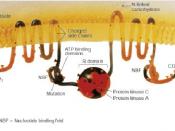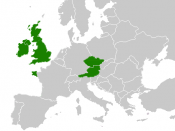Ion channels are transmembrane proteins that aid in the maintenance of inorganic ion homeostasis within the cell by selectively importing and exporting ions across the plasma membrane. These proteins form a hydrophobic pore across the membrane to connect the extra cellular matrix with the cytosol of the cell. These channels are not continually open; rather they are controlled by external/internal chemical, electrical, or mechanical factors. These external factors cause a change in the conformational shape of the channel truing the flow of ions on or off. A rapid influx of ions down their concentration gradient, through the open channel, created a difference in the electrical charge on either side of the membrane producing an electrical current. The ability to control the movement of ions is important in the proper functioning of many biological processes such as muscles contraction and nerve impulses. Ion channels serve a wide variety of critical functions in cells of every tissue in the body.
Not surprisingly, because of their influence of many biological processes, ion channels are involved in many debilitating diseases. One disease in particular, cystic fibrosis is extremely fatal. It is caused by the mutation in the chloride ion channel in epithelia cells of exocrine organs.
In order to understand how ion channels contribute to the function of these and many more physiological processes in the body, as well as to understand how their function is altered by a mutation or pathogen, an understanding of how the movement of the ions through the channels relates to its structure and they interact with the environment is imperative. Patch clamp technique is a common technique used to study the electrical pulses produced by ion movement, which gives a direct and accurate understanding of how ion channels behave. Two german scientists named Erwin Neher and Bert Sakmann...


